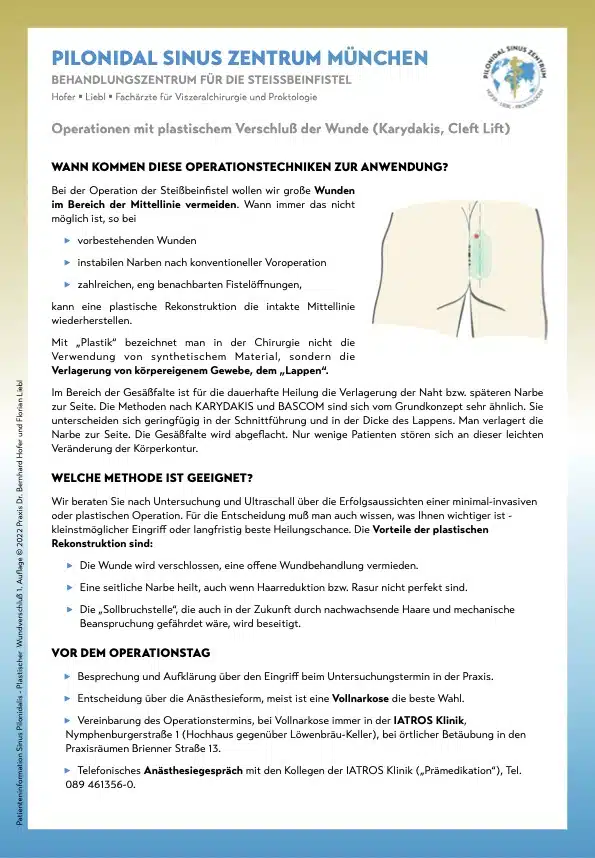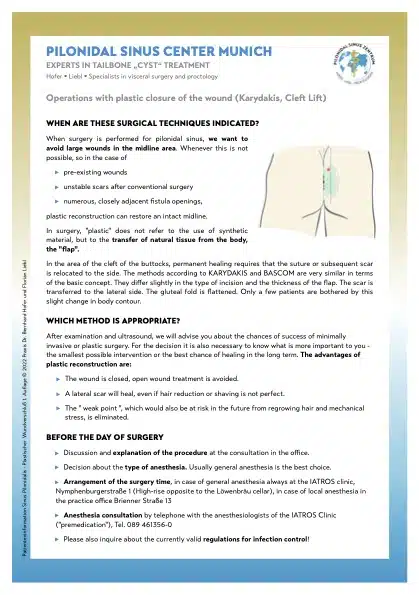Surgery of the Pilonidal Sinus (sinus pilonidalis): treatment procedure
There are basically two strategies available for the treatment of the pilonidal sinus, each of which has its specific advantages and disadvantages and differs in the course of treatment.
- Minimally invasive treatment , as the name suggests, is a minor surgical procedure that can be performed on an outpatient basis in our office under local anesthesia. For this we offer our " all-in-one" appointment, where the surgery can be performed directly after the examination and consultation. This method is suitable for patients with non-pre-operated coccygeal fistulas as well as for recurrences, provided there are no major midline defects. Another advantage of minimally invasive surgery is that in the rare case of recurrence, both a repeat minimally invasive treatment and other techniques remain possible.
- Removal of the fistula with primary wound closure requires more surgical effort, but offers the patient the advantage of a closed wound with usually less need for care. The lateral displacement of the scar also makes hair removal by shaving or laser less important. However, this procedure often requires a separate appointment at an outpatient surgery center under general anesthesia to provide optimal conditions. This method is too costly for most fistulas that have not been preoperated on, but is often a very good and effective long-term option for recurrences. It is also chosen when a previous surgical procedure has resulted in a protracted and frustrating healing process and the patient desires treatment with rapid completion.
Step 1: Diagnosis pilonidal sinus

Step 2: Find appointment
The easiest way to do this is to book an appointment directly in our online calendar:
- The diagnosis is clear and you want surgical treatment directly following the examination and consultation? Then the appointment category "Examination/Treatment Pilonidal Sinus All-in-one" is made for you. You book a 2-hour appointment with treatment option - a great relief for all those who want to avoid a second trip and have already presented to a specialist.
- If you are still unsure or want to take your time to consider the decision, we recommend that you select "Special consultation Pilonidal Sinus /Sinus pilonidalis". This will give you a 20-minute appointment for examination and consultation. We will then make an appointment for the operation according to your wishes. Such a consultation appointment is also essential if surgery under general anesthesia is to be scheduled, either at your request or if medically necessary.
We need this information from you (for all-in-one):

Photo documentation
Overview image

Photo documentation
Detail image
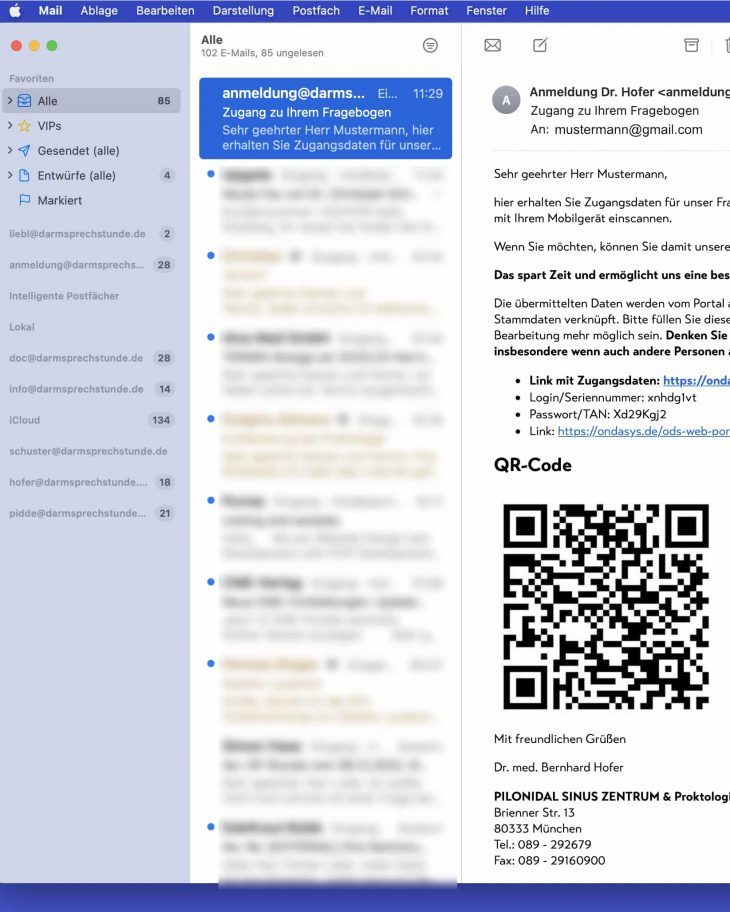
Online
Questionnaire
Please note that examination or treatment for other diagnoses (hemorrhoids, anal fistulas, etc.) is not possible on these dates due to lack of space and/or personnel.
An appointment requested via our booking system will only be confirmed by the physician if either the patient has already been examined in our practice or image documentation has been submitted in advance and the online questionnaire ("Access to Ondasys") has been completed.
Step 3: Preparation for the appointment
Decision for surgery and informed consent / consent for surgery
- You have understood why we advise you to have Karydakis or Cleft Lift surgery
- You have signed the consent form and read and understood our leaflet, the signed consent is available in the practice
- The date of the operation was firmly agreed with us
Preparation for the anesthesia interview:
- Please let us know if any significant illnesses (heart, lungs, blood clotting) are known or if there are any intolerances or allergies to be considered (especially local anesthetics or antibiotics)
- Please complete the Anesthesia Questionnaire as far as the questions are applicable to you(sample questionnaire)
Organize an adult to pick you up: After surgery under anesthesia, an adult must be available to pick you up. You are not allowed to go home alone, even by cab or public transport.
Here's what you should have prepared for the day of surgery:
- You have received the Iatros Clinic info sheet with the emergency cell phone number.
- You have told us whether you need a certificate of incapacity for work.
- Ideally, you have already received the prescription for painkillers and antibiotics, if necessary, and obtained the medications and panty liners.
Step 4: On the day of surgery
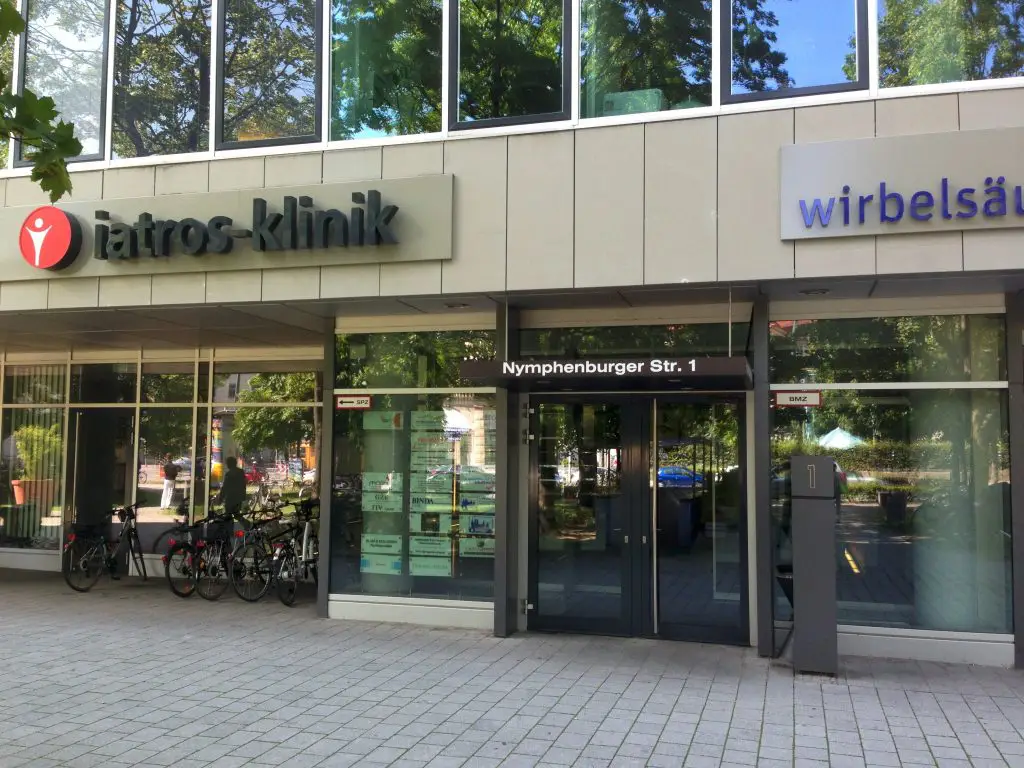
Operations with anesthesia take place in the Iatros Clinic, not in the practice. You will find the clinic at Nymphenburger Str. 1, 80335 Munich, on the second floor of the high-rise building opposite the Löwenbräukeller on Stiglmaierplatz. Please expect intense city traffic, especially during rush hour, and unexpected routing due to numerous construction sites. Therefore, plan enough time, this will help avoid stress. There is (somewhat narrow) parking for patients with entrance from Seidlstraße. Otherwise, the subway and streetcar go to Stiglmaierplatz.
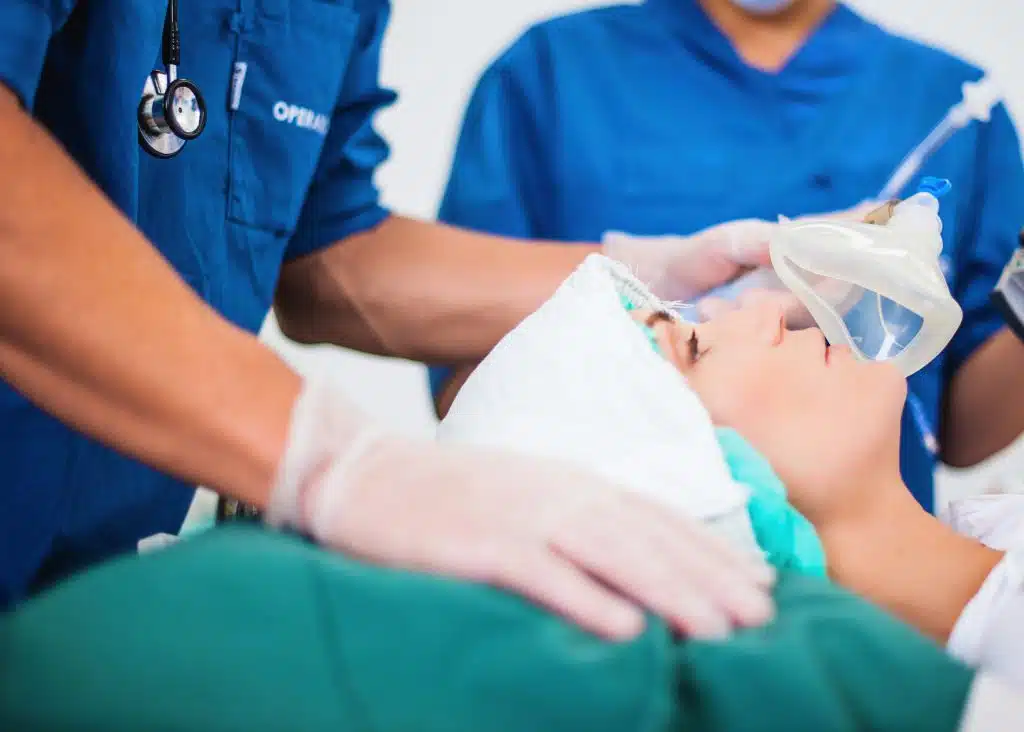
For the procedure under general anesthesia, you must be fasting for 6 hours. This means no food intake, no smoking, no chewing gum, no coffee - in short, anything that could stimulate the stomach acid.
If possible, we ask you to shave the buttocks generously. This makes it easier for us to work and for you to change the dressing if it does not stick to your hair.
And: shower out the region of the butt crease as much as possible, this reduces the density of bacteria on the skin.
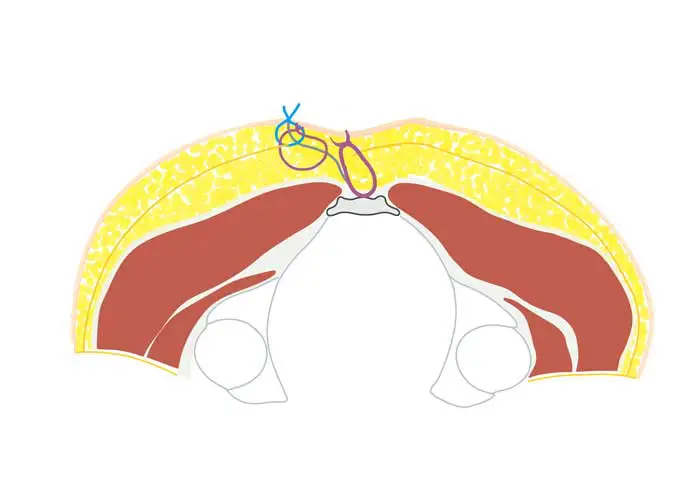
The principle of reconstruction in the area of the gluteal fold is the displacement of the suture to the side, i.e. asymmetric wound closure. The preferred technique is the operation according to Karydakis. Tissue ("flap") is mobilized from the side and the wound is covered with it. The wound is stably sutured in 3 layers. The sutures are dissolvable and are knotted countersunk so that no sutures are visible on the surface.

- After the surgery is completed and the dressing is applied, you will be taken to the recovery room for monitoring.
- The surgeon will inform you about the course of the operation and any special features to be observed.
- If, exceptionally, the patient is discharged while the surgeon is still working on another procedure or is no longer at the clinic, you can consult him or her via e-mail or the mobile number provided.
- You will receive a packet of dressing material or bandages and, if you have not already received this in the practice, the sick note and a prescription for painkillers.
- The anesthesia colleagues will discharge you as soon as there are no more concerns from the anesthesia and circulation sides.
Step 6: On the way home
After the procedure, the local anesthetic administered in addition to the anesthetic usually continues to work for several hours. You can and may therefore assume a normal sitting position in a car or train without pain. A slight pressure on the wound is even desired and reduces the already low risk of post-operative bleeding.
They should be accompanied by their collector for 24 hours after the procedure and are also not allowed to drive or operate machinery during this time. Patients with a very long journey usually go to a hotel over the weekend and come to the practice on Monday for a final check-up before going home.
Step 7: Aftercare
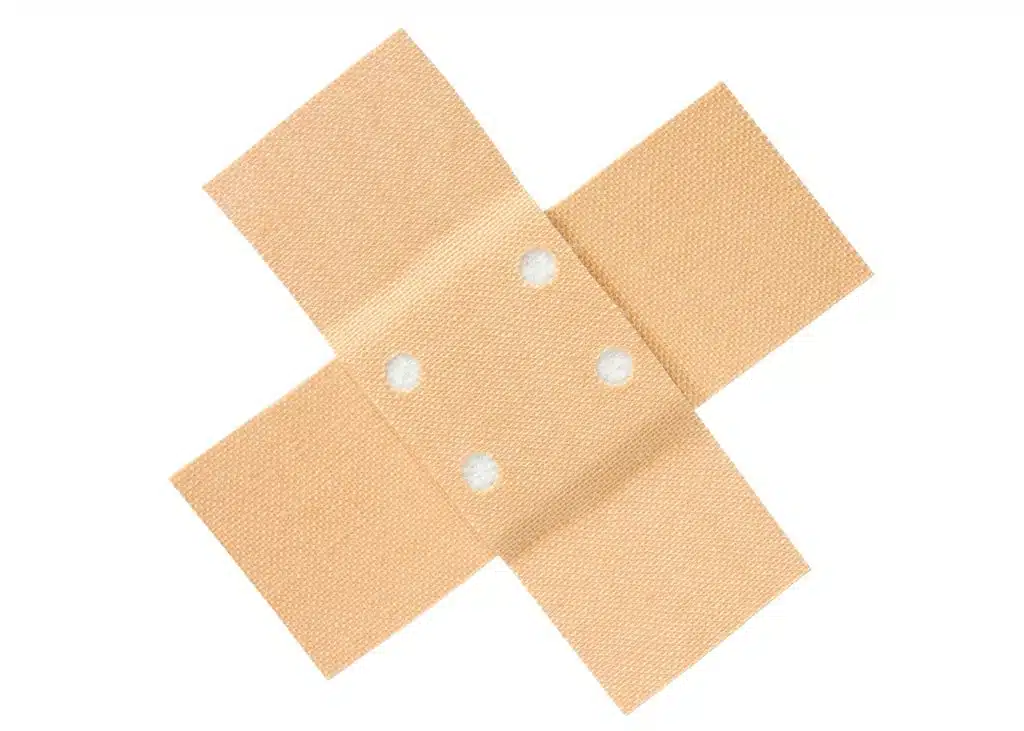
- The great advantage of the Karydakis operation is that there is no need to deal with open wounds and complicated dressing changes. The bandage, which is applied at the end of the operation, can be removed on the first or second day after the operation itself.
- There are skin-colored adhesive strips (Steri-Strips) directly on the skin, which can be left until they peel off by themselves. If this does not happen, they usually become somewhat unsightly and should then best be removed after showering.
- For further dressing changes, you can use commercially available quick dressings or, from the third day, leave the wound open and wear only a panty liner in your underwear.
- The skin threads are dissolvable and usually not visible, so they do not need to be removed.
- Shaving is not necessary according to most experts. We believe that at least in the lower half of the scar it is not a mistake to shave the edges of the wound once a week.

- Everyday activities (walking, sitting) are allowed immediately as long as they do not cause more severe pain. Of course, as a freshly operated person, you will not drop into the armchair swinging.
- Sports and bathing should be paused for 2 weeks after Karydakis surgery.
- Showering is allowed and encouraged from the 2nd postoperative day.
- Most patients are on sick leave for 2-3 weeks, since especially long periods of sitting in the office or in the car are initially not possible without pain and are not conducive to healing.

- Painkillers: Most patients do not complain of extreme pain and manage well with the as-needed intake of ibuprofen in a dosage of up to 3 x 600 mg. If, exceptionally, more severe pain occurs, please contact us. We can then firstly prescribe stronger painkillers and secondly check the wound for rarely occurring post-operative bleeding or wound infections(Info FlyerPainkillers/English).
- Antibiotics: The standard is a single administration of a cephalosporin antibiotic at the time of induction of anesthesia ("single-shot" prophylaxis). If the individual circumstances make a longer antibiotic therapy seem reasonable, you will receive a prescription for it from us.
- Bleeding / post-operative bleeding: During surgery, we perform very careful hemostasis so that bleeding is rare overall. If postoperative bleeding occurs, it is less visible externally when the wound is closed than through swelling of the soft tissues and discoloration as in a hematoma. A need for action arises from this only in the case of very pronounced hematoma formation or also extremely painful conditions. Normally, the matter calms down by itself.
- Seroma formation: A seroma is a collection of a clear, yellow, sometimes bloody fluid that can form in a cavity under the skin after plastic surgery procedures in which flaps of skin or tissue have been displaced or transplanted. This fluid buildup occurs when lymph fluid accumulates and is not properly absorbed by the body. Such seromas are not uncommon after Karydakis surgery. When sitting, you feel like you are on a waterbed. When this fluid finds its way through the scar, the impression of acute bleeding can arise. Then it is a matter of keeping calm, showering off the area and putting on an absorbent pad! In most cases, a seroma is harmless and will disappear on its own over time as the body reabsorbs the fluid. The resulting opening will heal on its own, as the scar is now on the side.
- Wound infection: Infections are very rare overall. They manifest themselves as redness, swelling and pain and are sometimes difficult to distinguish from non-inflammatory seroma. Please contact us if you are unsure.
- Suture dehiscence: Occasionally, small open areas form, often caused by delayed suture dissolution or inappropriate hair regrowth. In these cases, removal of the suture or shaving and application of an antiseptic ointment (e.g. PVP iodine) helps.
Step 8: Treatment completion and recurrence prophylaxis
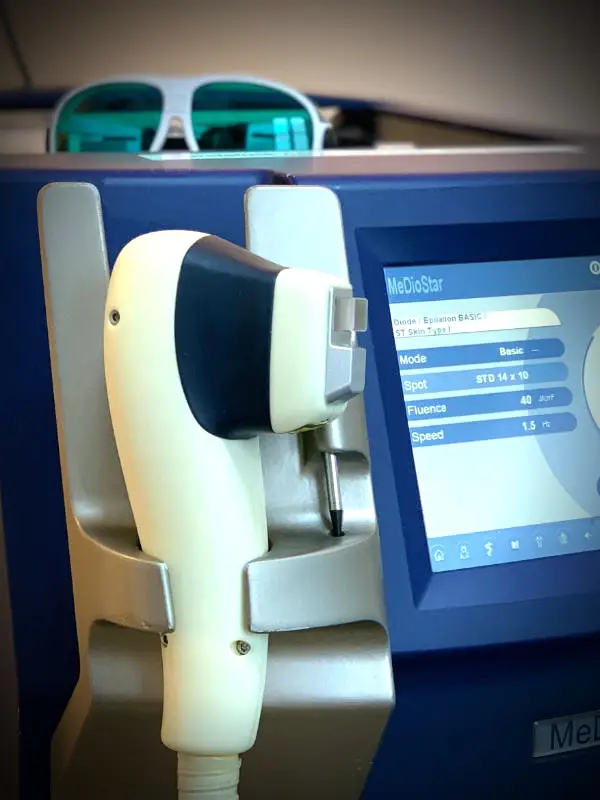
If the process is normal, a stable scar can be expected after about three weeks. The swelling conditions will also have improved by this time, at least to the extent that there is no longer any significant restriction.
Sports and professional activities can be resumed.
Permanent hair removal by laser epilation is not recommended by all experts in Karydakis surgery. The importance is certainly lower than for a scar in the midline.
Especially after several recurrences, we believe it can still be a worthwhile investment to permanently remove the hair in the gluteal fold and around the scar.

